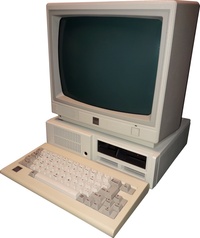|
The IBM PCJr (read "PC junior") was IBMs first attempt to enter the home computer market. The PCjr, IBM model number 4860, retained the IBM Pcs 8088 CPU and Bios interface for compatibility, but various design and implementation decisions led the PCjr to be a commercial failure.
It's small size and infrared keyboard which is powered by 4 AA batteries make it an interesting addition to the IBM range.
Announced November 1, 1983, and first shipped in late January 1984, the PCjr—nicknamed "Peanut" before its debut came in two models: the 4860-004, with 64 KB of memory, priced at US$669 (equivalent to $1,609 in 2016); and the 4860-067, with 128 KB of memory and a 360 KB 5.25-inch floppy disk drive, priced at US$1,269 (equivalent to $3,051 in 2016). It was manufactured for IBM inLewisburg Tennessee by Teledyne. The PCjr promised a high degree of compatibility with the IBM PC, which was already a popular business computer, in addition to offering built-in color graphics and 3 voice sound that was better than the standard PC Speaker sound and colour graphics of the standard IBM PC and compatibles of the day. The PCjr is also the first PC compatible machine that supports page flipping for graphics operation. Since the PCjr uses system RAM to store video content and the location of this storage area can be changed, it could perform flicker-free animation and other effects that were either difficult or impossible to produce on contemporary PC clones.
George Morrow was one of the few to be pessimistic about the PCjr after its announcement, predicting that Commodore's Jack Tramiel would "make mincemeat" of the "toylike" computer. "Somehow the mighty colossus looked a lot smaller that day", Popular mechanics wrote of the announcement, calling PC jr "a terrible disappointment". InCider agreed that the computer was disappointing, but observed that "no product could have lived up to the jr's pre-release publicity". The New York Times noted that "After all that waiting, it seems odd that no one appears particularly enthusiastic about the machine".Several Infoworld writers criticized the computer. Offering a "contrarian view: the PCjr could actually turn out to be a dog", Gantz wrote that "it's consumer and buyer demand that will spell success, not how awesome IBM is. It's still a free country, we don't have to buy the PCjr." John Dvorak joked that "champagne corks were popping all over the place. The bottles were being opened by Apple shareholders". John Clapp called PCjr "a pathetic, crippled computer", but glumly expected that "the magic letters IBM" and the company's enormous financial and marketing resources would let it "get away with this stuff".
Dvorak added that after the PCjr announcement "I go to my local ComputerLand dealer and everyone there is depressed. 'I'm not sure I even want to carry it,' said the manager", in contrast to the reaction to the PC. Despite Clapp's fear, when the PCjr became widely available in early 1984sales were below expectations. One store owner reported that "Interest was at a fever pitch" after the announcement, but "Once we had a demonstration model (in January), the only thing I can say is that the response was underwhelming".Stores began discounts almost immediately, and IBM admitting that demand was "variable and not growing as expected"began unusually early discounts of up to US$370 in June, but many of its 1,400 dealers could not sell their initial allotments of 25 computers. "Inventory is beginning to pile up", Time wrote in April; by August InfoWorld described it as "the colossal flop that the experts said couldn't happen";and in December Time stated that the PCjr "looked like one of the biggest flops in the history of computing...[it] sold as sluggishly as Edsels in the late 1950s".
Our model is complete in it's two boxes.
Manufacturer: IBM
Date: 1st November 1983
Comment on This Page
Magazines RELATED to IBM PC Jr 4860-067 in our Library
Other Systems Related To IBM PC Jr 4860-067:
This exhibit has a reference ID of CH46513. Please quote this reference ID in any communication with the Centre for Computing History.
|
|
Click on the Image(s) For Detail
|














